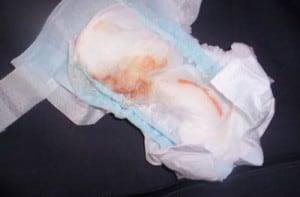Everything Parents Need to Know About Urate in Nappies
Hey there, amazing parents and guardians! If you’ve spotted some surprising, orange-colored stains in your baby’s nappy and felt a pang of concern, worry not! You most likely just encountered urate crystals. Let’s dive into the bright world of baby urates, and I’ll guide you through everything you need to know!
What Are Urate Crystals?
First off, those little orange spots are known as urate crystals, also referred to as “brick dust” due to their color and appearance. They’re completely normal for newborns and usually appear in the first few days after birth. Urate crystals are a result of uric acid in the urine, which can be more concentrated during this time. So, take a breath; it’s usually no reason to hit the panic button.
Why Do Urate Crystals Appear in Nappies?
In the early days of life, your bundle of joy has a lot of adapting to do! A newborn’s kidneys are learning how to efficiently filter blood and process waste. Because of this, uric acid levels can be a tad higher, which can lead to the formation of these crystals. Being slightly dehydrated can also cause urate to appear. It’s all part of the fascinating journey your baby takes while adjusting to life outside the womb.
Are Urate Crystals a Sign of Dehydration?
It’s normal to wonder if those nappy stains imply that your little one isn’t getting enough fluids. In most cases, urate crystals are not a cause for alarm and they often clear up as your baby’s liquid intake increases and their kidneys mature. However, if you’re concerned that your baby isn’t feeding well or the urate crystals persist beyond the first week, it’s a good idea to check in with your pediatrician. They’re the superheroes without capes who can offer peace of mind and guidance.
How to Monitor and Manage Urate Crystals?
Keeping an eye on the frequency and appearance of those nappy surprises is key. A good rule of thumb is to expect about as many wet nappies as your baby is days old, up to about a week. And remember, the early stools, called meconium, should transition to a yellow color as your baby starts digesting breast milk or formula. If you’re seeing persistent urate crystals beyond the newborn stage, increase feeds if possible and consult your doctor for advice.
What You’ll Learn in This Guide
- The science behind urate crystals and why they’re not as scary as they seem.
- How to tell if urate crystals are a sign of something more significant.
- Practical steps to ensure your baby is well-hydrated and happy.
- When to seek medical advice about urate in nappies.
Stay tuned as we explore the ins and outs of baby hydration, decode the color codes of newborn nappies, and make sure you have all the know-how to keep your baby smiling and healthy. Because let’s face it, as parents, we could all use a little less stress and a lot more clarity when it comes to these little wonders! So, grab your favorite snuggly blanket, cuddle up with your little one, and read on for more insights into the fascinating world of baby health.
Now, let’s get right down to the nitty-gritty, shall we? I promise, by the end of this guide, you’ll be a certified urate crystal guru, equipped with the knowledge to navigate this common, yet often misunderstood, phenomenon. So keep your chins up, dear parents, because we’re about to unravel the mystery of urate crystals together!

5 Essential Things Parents Should Know When Preparing for Urate in Nappies
As we move forward, there’s a checklist that can help ease any worries and keep you prepared for urate crystals in your baby’s nappy. Here are five must-know pointers:
- Understanding Newborn Hydration Needs: Newborns need to consume a small amount of fluids at frequent intervals. Breastfeeding moms should offer the breast often, while bottle-feeding parents must ensure they follow the guidelines for formula preparation and feeding schedules. If feedings are consistent, but you still see urate crystals, it could simply be a sign of your baby’s body adjusting.
- Diaper Diary: Keep a log of diaper changes that includes the number of wet diapers and any occurrence of urate crystals. This helps in monitoring your baby’s output and ensuring they are on the right track. If urate crystals continue to appear after the first week, you’ll have detailed notes to discuss with your pediatrician.
- Feeding Techniques: Sometimes latching issues or incorrect bottle-feeding angles can affect how much your baby drinks. Mastering the art of a good latch and bottle-feeding can ensure optimal fluid intake, reducing the chances of urate crystal formation due to dehydration.
- Signs of Adequate Feeding: In addition to monitoring the nappy, watch for signs your baby is getting enough milk, such as swallowing sounds, satisfaction cues after feeds, and steady weight gain. Always reach out to lactation consultants or your doctor if you have concerns about feeding.
- Temperature Moderation: A hot environment can cause your baby to lose fluids through sweat, which can contribute to dehydration. Keep your baby comfortably warm, not hot, and adjust their clothing according to the weather.
Now that we’ve laid down these key tips, we can explore further and understand urates at a deeper level.
Detailed Look at Baby’s Fluid Balance and Urate Production
Babies process fluids differently than older children and adults. Their bodies are fine-tuning, which means their kidneys are still maturing, and their fluid requirements are unique. The concentration of urine can fluctuate, leading to the appearance of urate crystals. But as you keep track of the feeds and diapers, you’ll soon notice patterns that will reassure you of your baby’s well-being. Incorporating good feeding practices along with monitoring, will almost always ensure that any issues with urate crystals will resolve naturally.
Professional Insights on Urate Crystals
If you’re facing persistent doubts or urate crystals, professional insights can never be undervalued. Pediatricians and neonatal nurses have seen it all and can provide context regarding whether your baby’s condition is within the range of normal or if it calls for further investigation. Always feel empowered to seek their expertise – remember, you are your baby’s advocate, and you are not alone on this journey.
Understanding the nuances of your baby’s health can be complex, but with love and a little knowledge, you’re already doing great. Paying attention to the details ensures you’re providing the best care possible. So, let’s embrace the unexpected and face it with confidence, because you, dear parents, are doing an awesome job!
Remember: While urate crystals can be a typical newborn phenomenon, you know your baby best. Trust your instincts, keep informed, and maintain open communication with your child’s healthcare team. With this comprehensive guide on urate in nappies, you are well on your way to becoming a urate-aware parent, ready for whatever comes your way in this incredible adventure of raising a little human. Keep smiling and cherishing these precious moments!
See more great Things to Do with Kids in New Zealand here. For more information see here
Disclaimer
The articles available via our website provide general information only and we strongly urge readers to exercise caution and conduct their own thorough research and fact-checking. The information presented should not be taken as absolute truth, and, to the maximum extent permitted by law, we will not be held liable for any inaccuracies or errors in the content. It is essential for individuals to independently verify and validate the information before making any decisions or taking any actions based on the articles.




